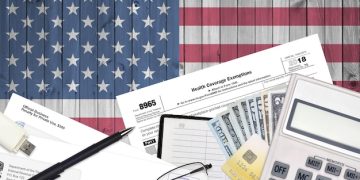Ensure Employee Benefits Compliance with 2025 IRS Guidelines

Are Your Employee Benefits Compliant with the Updated 2025 IRS Guidelines? Staying informed about the updated 2025 IRS guidelines is crucial for businesses to guarantee their employee benefits packages comply with the law, avoiding potential penalties and ensuring employee satisfaction.
Navigating the complexities of employee benefits can be daunting, especially with the ever-evolving regulations set forth by the IRS. As we approach 2025, it’s crucial to ask: Are Your Employee Benefits Compliant with the Updated 2025 IRS Guidelines? This article will guide you through the key changes and considerations to ensure your company’s benefits package meets all the necessary requirements.
Understanding the Core of IRS Compliance for Employee Benefits
The IRS plays a pivotal role in overseeing employee benefits, ensuring that companies adhere to specific standards and regulations. Understanding the core principles of IRS compliance is essential for avoiding penalties and maintaining a positive relationship with both employees and the government. Let’s explore the essential elements of this compliance.
Key Areas of IRS Oversight
The IRS focuses on several key areas within employee benefits to ensure fair and consistent application of the law.
- Health Benefits: Compliance with the Affordable Care Act (ACA) and other health benefit regulations.
- Retirement Plans: Proper management and reporting of 401(k)s, pensions, and other retirement savings plans.
- Fringe Benefits: Tax treatment of non-cash benefits such as life insurance, dependent care assistance, and transportation benefits.
Companies must stay vigilant and proactive to ensure they meet these standards.
Why Compliance Matters
Compliance with IRS guidelines is not merely a formality; it has significant implications for employers and employees alike.
- Avoiding Penalties: Non-compliance can lead to substantial fines and legal repercussions.
- Attracting and Retaining Talent: Competitive, compliant benefits packages can attract and retain top employees.
- Boosting Employee Morale: When employees trust that their benefits are managed correctly, it enhances their overall job satisfaction.
Staying on top of these regulations is crucial for a successful business.
Understanding the core of IRS compliance involves recognizing the specific areas of oversight and the critical reasons why compliance matters. By staying informed and diligent, your company can avoid costly penalties, attract top talent, and boost employee morale.

Major Changes to Employee Benefits in 2025
As we look ahead to 2025, several major changes to employee benefits are set to take effect. These changes span various aspects of benefits, from retirement plans to health savings accounts. Staying informed about these updates is crucial for ensuring your company remains compliant.
Updates to Retirement Plans
Retirement plans often see regulatory adjustments, and 2025 is no exception.
Key changes include:
- Increased Contribution Limits: Higher limits for 401(k) contributions to help employees save more.
- SECURE Act 2.0 Provisions: Further implementation of the SECURE Act 2.0, impacting required minimum distributions (RMDs) and catch-up contributions.
- Expanded Auto-Enrollment: More businesses are required to auto-enroll employees in retirement plans.
Employers should review these changes carefully to update their plan documents and communication strategies.
Health Savings Account (HSA) Adjustments
HSAs are a popular tool for managing healthcare costs, and there are important adjustments to be aware of for 2025.
- Inflation Adjustments: Contribution limits and deductible amounts may increase due to inflation.
- Eligibility Requirements: Updates to the requirements for high-deductible health plans (HDHPs) that are paired with HSAs.
Changes in Family and Medical Leave Policies
Family and medical leave policies are also subject to ongoing revisions to ensure they meet the needs of today’s workforce.
- Expanded Leave Definitions: Updates to what qualifies as a valid reason for taking family and medical leave.
- Increased Employer Flexibility: New guidelines on how employers can manage and administer leave requests.
Compliance with these policies ensures that employees can take the leave they are entitled to without fear of job loss or financial hardship.
Keeping abreast of these changes is essential for HR professionals and business owners. By understanding the updates to retirement plans, HSAs, and family and medical leave policies, you can proactively adjust your benefits offerings to stay compliant and competitive.
Steps to Ensure Compliance with the IRS Guidelines
Ensuring compliance with IRS guidelines requires a proactive and structured approach. By following a series of well-defined steps, companies can minimize the risk of non-compliance and maintain a smooth, efficient benefits program.
Conduct a Benefits Audit
A comprehensive benefits audit is the first step toward ensuring compliance. This involves reviewing all aspects of your benefits program to identify any potential issues or gaps.
Engage with Legal Counsel
Consulting with legal counsel specializing in employee benefits is essential. A qualified attorney can provide guidance on navigating complex regulations and ensuring your benefits program complies with all applicable laws.
Regular Employee Communication
Keeping employees informed about their benefits and any changes to the program is crucial. Clear and consistent communication can prevent misunderstandings and promote employee satisfaction.
Compliance with IRS guidelines is an ongoing process that requires consistent effort and attention to detail. By conducting regular audits, engaging with legal counsel, and maintaining open communication with employees, companies can safeguard against non-compliance and maintain a thriving benefits program.
Common Pitfalls to Avoid in Employee Benefits Compliance
Navigating employee benefits compliance can be complex, and there are several common pitfalls that companies often encounter. Being aware of these pitfalls can help your organization avoid costly mistakes and maintain a compliant benefits program.
Misclassifying Employees
One of the most significant pitfalls is misclassifying employees as independent contractors. This can lead to significant tax and benefits-related issues.
Neglecting to Update Plan Documents
Failing to update plan documents to reflect changes in the law or company policy is another common mistake. Updated documents are essential to ensure your benefits program remains compliant.
Failing to Perform Regular Audits
Regular audits are crucial for identifying and addressing compliance issues. Neglecting to perform these audits can leave your company vulnerable to penalties and legal action.
Avoiding these common pitfalls requires vigilance, careful planning, and a commitment to staying informed about the latest regulatory changes. By taking these steps, companies can protect themselves from potential liabilities and create a benefits program that meets the needs of their employees while complying with the law.

Tools and Resources for Staying Compliant
Staying compliant with IRS guidelines requires access to the right tools and resources. Fortunately, there are numerous options available to help companies navigate the complexities of employee benefits compliance.
Online Compliance Platforms
Several online platforms offer tools for managing and tracking employee benefits, ensuring compliance with relevant regulations. These platforms often provide features such as automated reporting, compliance alerts, and document management.
IRS Publications and Guidelines
The IRS provides a wealth of information through its publications and guidelines. These resources offer detailed explanations of the regulations and provide practical guidance on how to comply with them.
Professional Benefits Consultants
Engaging with a professional benefits consultant can provide expert guidance and support in navigating the complexities of employee benefits compliance. Consultants can help companies design and administer benefits programs that meet their specific needs while staying compliant with all applicable laws.
Leveraging these tools and resources can significantly streamline the compliance process and help companies stay ahead of regulatory changes. By taking advantage of these offerings, organizations can ensure their employee benefits programs are well-managed, compliant, and beneficial to both the company and its employees.
Future Trends in Employee Benefits and Compliance
As we look to the future, several trends are emerging in the realm of employee benefits and compliance. Staying informed about these trends can help companies prepare for upcoming changes and maintain a competitive, compliant benefits program.
Increased Focus on Mental Health Benefits
There is a growing emphasis on mental health benefits as employers recognize the importance of supporting their employees’ overall well-being. This includes offering access to mental health professionals, providing stress management resources, and promoting a culture of openness and acceptance.
Personalized Benefits Packages
The trend toward personalized benefits packages is also gaining momentum. Rather than offering a one-size-fits-all approach, companies are allowing employees to customize their benefits to meet their individual needs and preferences.
Greater Automation in Compliance
Automation is playing an increasingly important role in employee benefits compliance. From automated reporting to AI-driven compliance checks, technology is helping companies streamline their compliance efforts and reduce the risk of errors.
These future trends highlight the ongoing evolution of employee benefits and compliance. By staying informed and adapting to these changes, companies can create benefits programs that meet the needs of their employees while remaining compliant with all applicable laws and regulations.
| Key Point | Brief Description |
|---|---|
| ✅ Annual Compliance Review | Regular assessment to ensure adherence to IRS rules and regulations. |
| 📅 Updated IRS Guidelines Awareness | Staying informed on regulatory changes for employee benefits in 2025. |
| 📊 Accurate Record Keeping | Maintain detailed records of all employee benefits and related transactions. |
| 🤝 Employee Communication | Regularly communicate benefits information to employees to maintain transparency. |
Are Your Employee Benefits Compliant with the Updated 2025 IRS Guidelines?
▼
The IRS primarily focuses on health benefits (ACA compliance), retirement plans (401(k)s and pensions), and fringe benefits (life insurance, dependent care) to ensure fair and consistent application of the law.
▼
Compliance helps avoid penalties, attracts and retains talent with competitive benefits packages, and boosts employee morale by ensuring their benefits are managed correctly and legally.
▼
Common mistakes include misclassifying employees, neglecting to update plan documents, and failing to perform regular audits. These can lead to penalties and legal issues.
▼
Resources include online compliance platforms, IRS publications, and professional benefits consultants. These tools provide guidance and support navigating complex regulations.
▼
Emerging trends include an increased focus on mental health benefits, personalized benefits packages, and greater automation in compliance efforts to streamline processes and reduce errors.
Conclusion
Staying compliant with the updated 2025 IRS guidelines for employee benefits requires a proactive and informed approach. By understanding the core areas of IRS oversight, keeping abreast of major changes, and utilizing available tools and resources, companies can ensure their benefits programs are both compliant and beneficial to their employees, fostering a positive and productive work environment.





